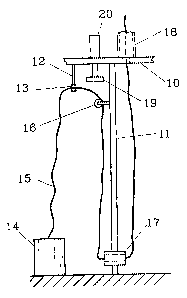Some of the information on this Web page has been provided by external sources. The Government of Canada is not responsible for the accuracy, reliability or currency of the information supplied by external sources. Users wishing to rely upon this information should consult directly with the source of the information. Content provided by external sources is not subject to official languages, privacy and accessibility requirements.
Any discrepancies in the text and image of the Claims and Abstract are due to differing posting times. Text of the Claims and Abstract are posted:
| (12) Patent: | (11) CA 2183229 |
|---|---|
| (54) English Title: | THREAD FEEDING BUFFER |
| (54) French Title: | TAMPON D'ALIMENTRATION EN FIL |
| Status: | Term Expired - Post Grant Beyond Limit |
| (51) International Patent Classification (IPC): |
|
|---|---|
| (72) Inventors : |
|
| (73) Owners : |
|
| (71) Applicants : |
|
| (74) Agent: | MARKS & CLERK |
| (74) Associate agent: | |
| (45) Issued: | 2007-01-02 |
| (86) PCT Filing Date: | 1995-02-13 |
| (87) Open to Public Inspection: | 1995-08-17 |
| Examination requested: | 2001-12-19 |
| Availability of licence: | N/A |
| Dedicated to the Public: | N/A |
| (25) Language of filing: | English |
| Patent Cooperation Treaty (PCT): | Yes |
|---|---|
| (86) PCT Filing Number: | PCT/SE1995/000144 |
| (87) International Publication Number: | WO 1995021787 |
| (85) National Entry: | 1996-08-13 |
| (30) Application Priority Data: | ||||||
|---|---|---|---|---|---|---|
|
A thread feeding buffer for feeding a fibre thread (15) from a
magazine roll (14) to a feed apparatus at a robot arm which is freely
movable in the room. The thread feeding buffer comprises thread
brake means (16, 19, 20) and at least one movable thread guide
(17), on which a thrust force is acting. The thread is running from
the magazine roll (14), via the brake means (16, 19, 20), through
the thread guide (17) and further on towards the feed apparatus in
such a way, that the thrust force acts for creation of a thread buffer
between the brake means and the feed apparatus, which buffer is
variable in length.
Tampon d'alimentation permettant de retirer un fil fibreux (15) d'un rouleau de stockage (14) et de le faire parvenir à un appareil d'alimentation au niveau d'un bras robotique pouvant se déplacer librement dans l'espace. Le tampon d'alimentation en fil comporte des organes (16, 19, 20) de freinage du fil, et au moins un élément mobile (17) de guidage du fil, cet élément étant soumis à une force de poussée. Le fil sortant du rouleau de stockage (14) s'étend jusqu'à l'appareil d'alimentation en passant par les organes de freinage (16, 19, 20) et l'élément de guidage (17), de telle sorte que la force de poussée crée un tampon de fil entre les organes de freinage et l'appareil d'alimentation, ce tampon étant de longueur variable.
Note: Claims are shown in the official language in which they were submitted.
Note: Descriptions are shown in the official language in which they were submitted.

2024-08-01:As part of the Next Generation Patents (NGP) transition, the Canadian Patents Database (CPD) now contains a more detailed Event History, which replicates the Event Log of our new back-office solution.
Please note that "Inactive:" events refers to events no longer in use in our new back-office solution.
For a clearer understanding of the status of the application/patent presented on this page, the site Disclaimer , as well as the definitions for Patent , Event History , Maintenance Fee and Payment History should be consulted.
| Description | Date |
|---|---|
| Inactive: Expired (new Act pat) | 2015-02-13 |
| Inactive: Office letter | 2014-05-01 |
| Inactive: Reversal of will be deemed expired status | 2014-05-01 |
| Letter Sent | 2014-02-13 |
| Maintenance Request Received | 2013-01-23 |
| Inactive: Office letter | 2010-03-15 |
| Inactive: Payment - Insufficient fee | 2010-02-23 |
| Inactive: Office letter | 2007-01-26 |
| Inactive: Corrective payment - s.78.6 Act | 2007-01-18 |
| Grant by Issuance | 2007-01-02 |
| Inactive: Cover page published | 2007-01-01 |
| Pre-grant | 2006-10-18 |
| Inactive: Final fee received | 2006-10-18 |
| Letter Sent | 2006-05-15 |
| Notice of Allowance is Issued | 2006-05-15 |
| Notice of Allowance is Issued | 2006-05-15 |
| Inactive: Approved for allowance (AFA) | 2006-02-28 |
| Amendment Received - Voluntary Amendment | 2005-12-30 |
| Inactive: S.30(2) Rules - Examiner requisition | 2005-07-19 |
| Amendment Received - Voluntary Amendment | 2003-01-13 |
| Inactive: Application prosecuted on TS as of Log entry date | 2002-03-12 |
| Letter Sent | 2002-03-12 |
| Inactive: Status info is complete as of Log entry date | 2002-03-12 |
| Inactive: Entity size changed | 2002-02-14 |
| All Requirements for Examination Determined Compliant | 2001-12-19 |
| Request for Examination Requirements Determined Compliant | 2001-12-19 |
| Application Published (Open to Public Inspection) | 1995-08-17 |
There is no abandonment history.
The last payment was received on 2006-02-01
Note : If the full payment has not been received on or before the date indicated, a further fee may be required which may be one of the following
Please refer to the CIPO Patent Fees web page to see all current fee amounts.
Note: Records showing the ownership history in alphabetical order.
| Current Owners on Record |
|---|
| APLICATOR SYSTEM AB |
| Past Owners on Record |
|---|
| KJELL SAND |